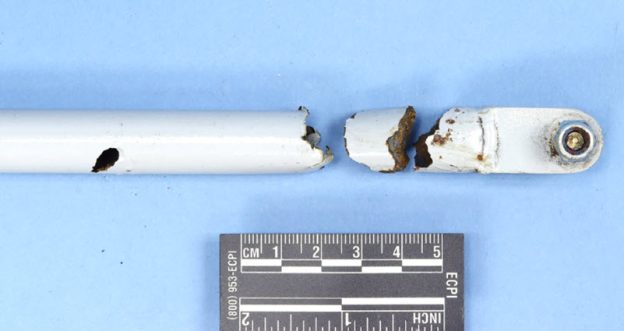Analysis
The pilot was departing on a local flight in the experimental glider when the glider unexpectedly separated from the towline shortly after liftoff. The glider then entered a left turn and landed in a wings-level attitude. The tail boom was substantially damaged during the landing. The tow airplane and the towline were not damaged during the event.
Postaccident examination determined that the elevator control tube installed in the vertical stabilizer was corroded along the entire length of its inner surface, reducing its wall thickness. Water likely entered the control rod, either through a witness hole near the upper end of the control tube or as moisture carried in by humid air. There was no rain hole at the bottom end of the control tube, and, as a result, there was no way for liquid water to drain out of the control tube.
The wall thickness eventually thinned sufficiently to cause the tube to burst in the longitudinal direction near its upper end. After the control tube burst, the resulting hole on the side of the tube allowed for the easy ingress of water that made its way past the boot seal. The corrosion product and standing water at the base of the tube eventually reduced the tube wall thickness to a point where it could no longer withstand the typical operational loads and subsequently fractured in overstress near the clevis fitting during the accident flight. The overstress failure of the control tube prevented the pilot’s control of the elevator during the accident flight. The last condition inspection of the glider was completed 24 days before the accident. The corresponding logbook entry noted that the flight controls were inspected and the glider was airworthy. The longitudinal fracture near the upper end of the elevator control tube would have been readily visible with the rubber boot removed, and, as such, it is likely the mechanic did not remove the rubber boot to adequately inspect the elevator control tube during the last condition inspection.
Probable Cause and Findings
The National Transportation Safety Board determines the probable cause(s) of this accident: The overstress fracture of the elevator control tube due to reduced wall thickness from water intrusion and subsequent corrosion. Contributing to the accident were the lack of a drain hole at the bottom of the elevator control tube, which allowed the tube to collect water, and the mechanic’s inadequate inspection of the elevator control system during the recent condition inspection.
Preventing Similar Accidents
Mechanics Manage Risk and Follow Procedures
Mistakes performed during aircraft maintenance and inspection procedures have led to in-flight emergencies and fatal accidents. System or component failures are the most common defining events for fatal general aviation accidents. Mechanics should learn about and adhere to sound risk management practices to prevent common errors; even well-meaning, motivated, experienced technicians can make mistakes. Fatigue can be a hazard even for mechanics, and it can be linked to forgetfulness, poor decision-making, reduced vigilance, and ultimately interfere with the mechanic’s ability to do the job safely.
Mechanics should carefully follow manufacturers‘ instructions to ensure the work is completed as specified. Also, up-to-date instructions and manuals should be used; other qualified mechanics are also a great resource. Mechanics need to pay close attention to the safety and security of the items that undergo maintenance, as well as the surrounding components that may have been disconnected or loosened during the maintenance. Inspecting maintenance work is a great way to ensure it is done correctly. Routine inspections should be thorough, and items needing immediate attention should be addressed rather than deferred. Source and entire report: ‚NTSB, National Transportation Safety Board‚.


